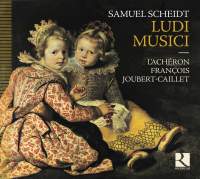Texte paru dans: / Appeared in: |
|
|
Outil de traduction ~ (Très approximatif) |
|
|
Reviewer: Barry
Brenesal Samuel Scheidt’s four instrumental collections of “musical games” have themselves been the sport of time. Of the lot, the second has lost its alto and continuo partbooks, the fourth survives only in its soprano line, while the third has completely vanished. Only the first, issued in 1621, exists in playable form today. It consists of 13 pieces in five parts and 19 in four. L’Achéron has chosen to record 16 of these, with viol consort accompanied by string and keyboard continuo. It’s certainly not the only instrumental grouping that can be deployed in these pieces. Jordi Savall’s 1978 recording with Hespèrion XX features a mix of strings, winds, brass, and continuo, while his second, from 1995 (currently available as a download, though used physical copies may be found for sale), focuses on the viol consort as well, with strings and keyboard continuo, and an occasional added percussion part. Les Sacqueboutiers (Ambroisie 9996) offers a standard “loud ensemble” approach, not counting continuo and a frequently added percussion part. Like so much ensemble music of the period, specific instruments weren’t usually noted. Scheidt only mentions it in two selections: a canzona for cornetts, and the dedication of the popular “Gagliard battaglia” to the Brandenburg court cornettist, Zacharia Hartelius. Even there, additional possibilities abound, with the “Gagliard” in particular being performed by a wide assortment of ensembles. Savall I gets the most color out of these pieces, as you might expect, given his Technicolor ensemble. L’Achéron, like Savall II, diversifies textures quite a bit despite the limited scale of its forces, mostly through discreet doubling with organ, virginal, or ottavino (as in the “Canzon super Cantionem Gallicam XXIX”), or supplying one of the lines to the theorbo (“Courant XI”). It helps as well that the viol consort core of this ensemble produces a rich, varied sound, capable of great warmth (“Courant X”), sweetness (“Paduan V”), and sharp, well-differentiated attacks (“Gagliard battaglia XXI”), as required. Tempos are varied, with L’Achéron never losing sight of momentum or the need for clarity between the parts.
With all four recordings
mentioned being attractively performed, the question of which to get becomes
a matter of instrumental taste, medium, and convenience. Certainly of the
two that are most easily found on disc, Les Sacqueboutiers sounds more
dramatic, and L’Achéron more intimate. If it helps, they also share only
eight selections, making the purchase of both albums more attractive from
the standpoint of non-duplicative content. In any case, check out both,
bearing in mind that you can’t go wrong with either. | |
|
|
|
|
Cliquez l'un ou l'autre
bouton pour découvrir bien d'autres critiques de CD |
|




